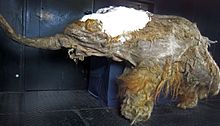Yuka (mammoth)
 The mammoth's mummified remains | |
| Species | Woolly Mammoth |
|---|---|
| Sex | Female |
| Died | 39,000 YA[1] Siberia |
| Known for | Best preserved woolly mammoth |
| Residence | Moscow |
| Weight | 5 tonnes |
| Height | 3 m (9 ft 10 in) |
| External image | |
|---|---|
Yuka is the best-preserved woolly mammoth (Mammuthus primigenius) carcass ever found. It was discovered by local Siberian tusk hunters in August 2010.[2][3][4] They turned it over to local scientists, who made an initial assessment of the carcass in 2012.[5] It is displayed in Moscow.
Discovery
The mammoth was found along the
The north-facing bluff was composed of
Research and analysis
After its discovery, Yuka spent two years stored and preserved in a natural refrigerator, the local permafrost ('lednik'), at Yukagir. At that time, the first scientists, P. Lazarev and S. Grigoriev, from the Mammoth Museum (Sakha Academy of Sciences, Yakutsk) arrived to study these mummified remains. By then, more than 100 meters (330 ft) of the low bluff had washed away. From Yukagir, the Yuka mammoth was transported to the Sakha Academy of Sciences in Yakutsk.[4][6] Since October 2014, the mammoth has been on display in Moscow and is regarded as being the best preserved Siberian mammoth discovered thus far.[1]
An analysis of the teeth and tusks determined Yuka to be approximately 6–8 years old when it died. Although it is presumed that this mammoth had most likely been attacked by lions or other predators, evidence that the predators had killed the mammoth was not found.[4][6]
In March 2019, a Japanese research team led by Kazuo Yamagata, a biologist at Kindai University, worked with Yuka's tissue.[7] Yamagata's team reported that they were able to stimulate nucleus-like structures to perform some biological processes.[7] However, they could not activate cell division.[8]
See also
- List of mammoths
- Adams mammoth
- Jarkov Mammoth
- Lyuba Mammoth
- Sopkarga Mammoth (Zhenya)
- Yukagir Mammoth
References
- ^ a b "39,000 year-old mammoth goes on display in Russia". BBC News. October 29, 2014. Retrieved November 7, 2022.
- ^ Yirka, Bob (April 5, 2012). "Well preserved mammoth from Siberia shows signs of early man stealing from lions". Phys.org. Retrieved February 4, 2021.
- ^ Potter, Ned (April 5, 2012). "Woolly Mammoth Apparently Butchered by Ancient Humans". ABC News. Retrieved February 4, 2021.
- ^ . Retrieved September 19, 2022.
- ^ Aviss, Ben (April 4, 2012). "Woolly mammoth carcass may have been cut into by humans". BBC News. Archived from the original on April 5, 2012. Retrieved February 4, 2021.
- ^ a b c Maschenko, E., Potapova, O., Boeskorov, G., Agenbroad, L., 2012. Preliminary data on the new partial carcass of the Woolly mammoth, Mammuthus primigenius, from Yakutia, Russia. Abstracts of the 72nd Annual SVP Meeting, October 17–20, 2012. p.137.
- ^ a b Ferreira, Becky (March 12, 2019). "Scientists Reawaken Cells From a 28,000-Year-Old Mammoth". Vice. Retrieved November 7, 2022.
- PMID 30858410.
External links
 Media related to Yuka (mammoth) at Wikimedia Commons
Media related to Yuka (mammoth) at Wikimedia Commons
